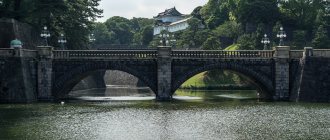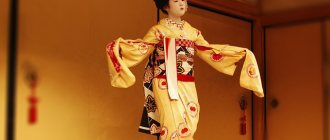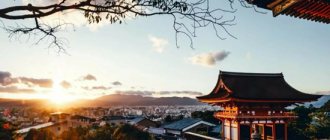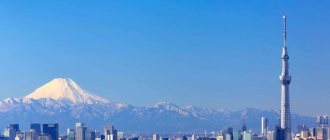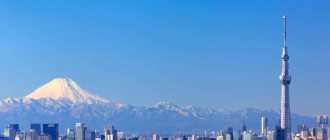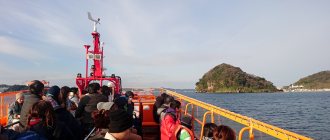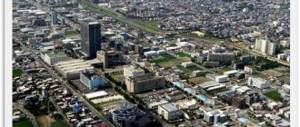Japan is an island country located in eastern Asia. The country is known for its highly developed infrastructure and modern technology, as well as its rich culture. However, tourists who are lucky enough to visit it are content mainly with visiting the capital - Tokyo, and excursion cities - Kyoto, Hiroshima. Because of this, one gets the erroneous impression that all of Japan is nothing more than a modern metropolis, although the country has very picturesque nature. In particular, it is worth paying attention to the rivers of Japan.
General information about rivers
Due to the geographical location of Japan, the rivers here cannot boast of large sizes. There are about 260 reservoirs in the country. Basically, they originate on mountain slopes, carve V-shaped valleys and, descending to the foothills, create alluvial plains. Residents of the country use rivers to cultivate rice fields or create residential settlements near such places.
In general, the length of Japan's rivers does not exceed 20 kilometers; the basin area is on average 130 square kilometers. However, real giants for this area are located on the territory of the country.
Flora of the state
About 2,750 plant species can be counted on the lands of Japan. Among these species, almost half are considered endemic. Japan's island location makes it difficult for the state to exchange natural resources with other lands, which makes the country unique in terms of natural science.
Lianas and ferns are found everywhere in Japanese lands. Gardenias, azaleas, and aralias fill the country's meadows. Bamboo grows in moist soils near water bodies.
Among the flora of Japan there are many plants that are cultivated by man himself. Rice fields give way to rapeseed fields, completely blending into the surrounding nature without any contradictions.
Endemics of the country include Cryptomeria japonica, Miyabe maple, some types of orchids and other plants. The law protects the flora of the Land of the Rising Sun, prohibiting the export of animals or plants from its territories.
Top 5 largest rivers in Japan
The top five greatest rivers in the country are:
- The Shinano River is the main and longest river. Its length is 368 kilometers. The river is located on the island of Honshu, near the city of Niigata, and flows into the Sea of Japan. Due to its size, Shinano is an important waterway for the island.
- The Tone River is also located on the island. Honshu. Its length is 322 kilometers. The river originates at the top of Mount Ominakami. It plays a big role in the development of the tourism industry: it is suitable for water sports, and one of the most famous hot spring resorts is located on its shores.
- The Ishikari River is 268 kilometers long and is considered the main source of fresh water on the island of Hokkaido. It begins near the foot of Ishikariyama and flows into the China Sea. The river bed is winding.
- The Kitakami River has perhaps the largest basin in the Tohoku region. Located on the island of Honshu, the length is 249 kilometers. During Edo times it was used to transport rice that was grown in its valley.
- The Abukuma River is the second longest in the Tohoku region - 239 kilometers. Its source is located on Mount Asahi. Abukuma flows into the Pacific Ocean.
Biwa
Deep Lake Biwa with clear fresh water, which formerly bore the name Omi, is today the largest on the Japanese map. It is located in Shiga Prefecture on the central part of the island of Honshu, northeast of Kyoto, the former capital of Japan. Biwa lies in a tectonic basin. This lake feeds the local Yodo River. More than 400 small rivers flow into it. The height of Biva above sea level is 85.6 m.
Biwa has four islands: Chikubushima, Takeshima, Okishima, Okinoshiroishi. The amazingly beautiful Japanese mountains rise above it. The lake is a fresh water reservoir for the major city of Kyoto and its surrounding areas. The lake contains more fish suitable for food. In autumn and spring, when the time of rains and local typhoons comes, the actual water level in the lake can rise by 3 meters.
Kasumigaura
Kasumigaura today is the second largest lake in the territories of modern Japan (after the world-famous legendary Biwa Island). It is located in the vicinity of Ibaraki in the Kanto region, on the eastern part of the island of Honshu. The area of this lake is as much as 220 km². Its average depth reaches 4 m, the maximum is 7 m.
The large rivers Sakura and Naka, as well as about 30 other small rivers and streams, flow into this reservoir. The large Tone River flows out of Lake Kasumigauri. The cities of Kasumigaura and Tsuchiura are located on the banks. Today the lake is used in the state's industry, for fishing, agricultural irrigation, and also for tourism.
Towada
Towada is the largest and most picturesque lake on the island of Honshu, which has a crater-type origin characteristic of such reservoirs. This lake-type reservoir is located at an altitude of 400 m within the state national park, on the border territories of Aomori and Akita. The walls of the caldera even reach a height of a thousand meters in several areas, as a result of which they are able to reach the summit on the Towada volcano at an altitude of 1159 m.
The bright blue, quite noticeable, tint of the lake water is, in fact, the result of its crystal purity and the noticeably great depth of the lake. Lake Towada is regularly visited by more than three million tourists every year. It is ideal for swimming and is a favorite vacation spot for travelers. Therefore, the infrastructure on the coast is well developed, there are numerous hotels and boarding houses.
The fastest
Along with large and flooding rivers, three fastest bodies of water can be distinguished:
- The Mogami flows through Yamagata Prefecture. The length is 216 kilometers, and the water flow is 250 m3 per second. The mouth of the river is the Sea of Japan.
- The source of the Fuji River is located on Mount Nokogiri, it ends at Suruga Bay, flowing into the Pacific Ocean. Its length is 128 kilometers. Current speed is 64 m3 per second.
- Kuma is located on the island of Kyushu. Its length is more than 115 kilometers. Current speed is 104 m3 per second. It flows into Yatsushiro Bay. It is considered the most popular place among tourists: in 1 year, about 70 thousand people visited its territory.
Mountain ranges and volcanoes of the country
It is worth knowing that 70% of the territories in the Land of the Rising Sun are occupied by mountains and volcanoes. Fuji, or simply the main dormant volcano, reaches a height of 3776 meters.
Approximately 200 dormant volcanoes can be counted in the archipelago country. A large active volcano is located on the large island of Kyushu. It has erupted many times, but the inhabitants of the island do not even think of moving from it, since the country is overpopulated.
Interesting to know
The rivers of Japan are very different from those that can be found on the continents: briskly descending the mountain slopes, they dissolve in the depths of the ocean. The largest rivers are used to transport timber, and river flows, which flow powerfully due to the difference in elevation, are an excellent way to generate additional electricity.
In addition to the fastest and largest rivers, the country has the most amazing bodies of water:
- The length of Kubore is only 85 kilometers, but the speed of the flow allows it to generate electricity - 10 power plants have been built along the river. In addition, the water here is of the highest quality in the country.
- Ateragawa has an amazing emerald color. Its length is only 15 kilometers, but the water is so clean and transparent that you can see every pebble at the bottom.
- The Kakita is one of the few rivers in Japan that arose from spring water. Its length is a little more than a kilometer. All year round, the water temperature is 15 degrees, which is why you can see many flocks of birds on the banks of the reservoir.
- Oirase is known as the Road of 27 Waterfalls. It is under guard.
River banks are considered the best place to relax in Japan. Of course, during the industrial boom, some reservoirs were damaged by waste from industrial enterprises, but today the government carefully monitors the preservation of nature.
Forests in Japan
The country's forests are represented by subtropical forests of plateaus and highlands. The following varieties are found among the trees of Japan:
- Oak trees;
- Laurel;
- Anise trees;
- Pasania;
- Magnolias.
The Japanese give sakura a special place in the nature of the state.
Sakura grows everywhere in Japan. The breathtaking flowering of trees begins in mid-March.
Nature has decorated the north of the state with coniferous forests. Spruces, pines, fir and cypress trees are interspersed with beech and maple trees. Hokkaido has a native spruce species named after the island.
Mineral resources (minerals)
The mineral resources of island Japan are scarce. There are several mines operating on the islands, thanks to which the Japanese have:
- zinc;
- gray;
- coal;
- lead;
- limestone.
Oil fields are being developed, but their potential is low.
Copper mines in the center of Honshu, in Ashio, were previously highly valued, but the resources have been completely depleted.
The country's supply of iodine is high. Valuable deposits of light, durable titanium have been discovered. In recent years, areas potentially rich in precious metals, heavy metals, and methane have been discovered. The reserves of the latter (according to scientists) will last approximately 100 years.
Minerals: table
| Region | Field |
| Kyushu, Hokkaido | Coal |
| Honshu, Hokkaido | Tungsten |
| Hishikari, Kyushu, Kushikino | Silver, gold |
| Honshu, Hokkaido, Shikoku | Manganese |
| Honshu | Uranus |
| Honshu, Sea of Japan | Oil Gas |
Salt is mined in coastal regions.
Fauna of Japan
Japanese macaque
The fauna of Japan is not as diverse as the flora. And this is due to Japan’s island isolation from the mainland. But this does not mean that rare species of animals are not found here. As well as representatives of the flora, the fauna of Japan contains pure endemics found only in these territories: green pheasant, Japanese dormouse, bamboo salamander, Japanese serow, Iriomote cat, giant salamander, etc. However, characteristic mainland animals are also found in Japan and then they receive the Japanese prefix: deer, macaque, bear, antelope, etc.
The entire fauna of Japan is represented by classes:
- Mammals
- Birds
- Reptiles and amphibians
- Fish
- Insects
Deer under cherry blossoms
And each of these classes is vast and widely represented in Japan. The most typical representatives of mammals living on the Japanese archipelago are the brown bear, Japanese macaque, sable, sika deer, squirrels, chipmunks and hares, wild boars, foxes, etc. The largest of them are brown and Himalayan bears. There are two species of wild cat in Japan, one of which is purely endemic - the Iriomotean cat and the Bengal cat. Some animals, as well as plants, have already become a symbol of Japan and are classified as sacred. Such animals include the sika deer. He is allowed to walk the streets in herds, lie on the sidewalk and wait for treats from local residents or guests of Japan.
Japanese green woodpecker
Representatives of the class of birds are no less interesting. This is about 600 species. Among them, of course, there are true endemics that inhabit purely Japanese lands: the Japanese green woodpecker, the copper pheasant and, of course, the green pheasant, which is a kind of symbol of Japan. His image is widely used in culture, painting, poetry, traditions and art. Certain species of birds are characteristic only of the islands: the island thrush and the yambaru-kuina. Japan is important for many migratory birds: cranes, swans and ducks.
Japanese giant salamander. Photo: Momotarou2012 / Wikimedia Commons
The class of reptiles is also very numerous and has about 70 species. Among them there are many poisonous species: sea turtles and snakes, tiger snake, yellow-green keffiyeh, oriental copperhead snake, etc. Some endemic colubrid snakes are found only on the islands: the island snake, the thin-tailed and fine-scaled climbing snake and the Japanese snake.
An interesting representative of reptiles is the Japanese salamander. This large lizard is up to 1.5 meters long with a peculiar camouflage color. Feels great in water, but is no less active on land. Has poor vision and therefore navigates in space using other senses.
Koi carp in the pond
The waters of the surrounding areas of Japan, Japanese rivers and lakes are inhabited by numerous species of fish, about 3000 species. Of the freshwater fish species, the most important are the common crucian carp and common carp. The so-called anadromous species of fish are also common here - fish that are born in fresh waters and migrate to sea waters to feed, and subsequently return back to their habitat. Such fish in Japan include several species of salmon. Among them are coho salmon, sockeye salmon, maza, chum salmon, chinook salmon and pink salmon. The same fish include the largest freshwater fish - Japanese taimen, sometimes reaching a length of up to 2 meters. Deep-sea sharks are also found off the coast of Japan - the goblin shark and the frilled shark.
Japanese giant hornet. Photo: Yasunori Koide/Wikimedia Commons
Representatives of insects inhabiting the territory of Japan are also interesting. Among the most unusual and very dangerous insects is the well-known one, reaching a body size of more than 5 cm in length. This is the largest representative of this family in the world. Its bite sometimes becomes fatal to humans. There are about 3,000 species of butterflies in Japan, many of which are found only here.

